![]()
![]()
![]()
Use LEFT and RIGHT arrow keys to navigate between flashcards;
Use UP and DOWN arrow keys to flip the card;
H to show hint;
A reads text to speech;
61 Cards in this Set
- Front
- Back
|
Difference between slip and separation 1 |
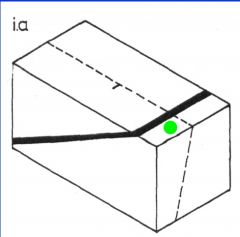
Pre-Faulting |
|
|
Difference between slip and separation 2 |
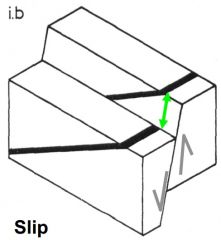
Slip - actual relative displacement between two points that occupied the same location before faulting. |
|
|
Difference between slip and separation 3 |
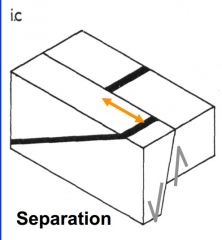
Separation - apparent relative displacement between two points that may have occupied the same location before faulting. |
|
|
Fault Recognition 1 |
Features of faults themselves: 1. Fault rocks, i.e. Fault Breccia ect. 2. Slickensides, slickenlines etc. |
|
|
Fault Recognition 2 |
Effects on stratigraphic units: 1. Break in continuous stratigraphic section; truncation of structures. 2. Don’t confuse faults w/ unconformities--upper units usually parallel to contact. 3.Horses (fault slices) = blocks surrounded on all sides by faults--usually displaced a large distance from original position 4. Repetition of strata. 5. Omission of strata. 6. Drag folds (also reverse drag). |
|
|
Fault Recognition 3 |
Effects on topography or geomorphology: 1. Scarps. 2. Offset ridges, valleys, streams. 3. Springs, sag ponds. 4. Nickpoints in streams. |
|
|
Modes of Fractures according to tip line 1 |
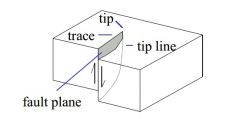
Tip line: line that separates slipped from unslipped rock; (where fault displacement goes to zero) tip line is a closed loop |
|
|
Modes of Fractures according to tip line 2 |
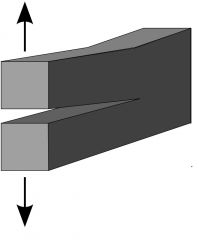
Mode I fracture: Opening mode 1. A tensile stress normal to the plane of the crack. |
|
|
Modes of Fractures according to tip line 3 |
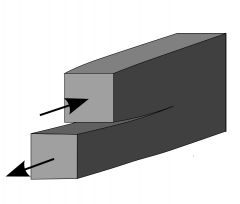
Mode II fracture: Sliding mode 1. A shear stress acting parallel to the plane of the crack and perpendicular to the crack front. |
|
|
Modes of Fractures according to tip line 4 |
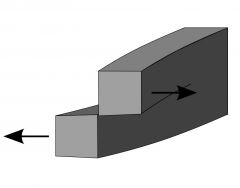
Mode III fracture: Tearing mode |
|
|
Fleuty's Fold Classification 1 |

|
|
|
Fleuty's Fold Classification 2 |
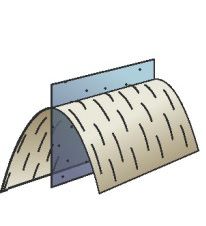
A. Upright: 1. Dip of axial surface is upright or plunge of hingeline is horizontal. |
|
|
Fleuty's Fold Classification 3 |
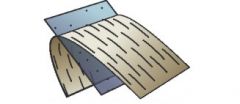
B. Horizontal inclined: 1. Moderately inclined axial surface and horizontal hingeline. |
|
|
Fleuty's Fold Classification 4 |
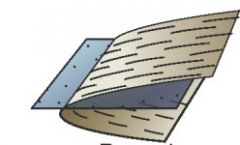
C. Recumbent: 1. Dip of axial surface recumbent and plunge of hingeline is horizontal, less than 10 degrees. |
|
|
Fleuty's Fold Classification 5 |
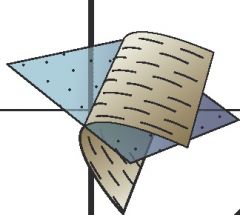
D. Plunging inclined: 1. Dip of axial surface at 60 degrees and plunge of hingeline at 30 degrees. |
|
|
Fleuty's Fold Classification 6 |
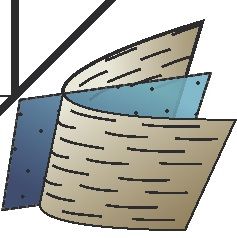
E. Reclined: 1. Dip of axial surface at 60 degrees and plunge of hingeline at 60 degrees. |
|
|
Fleuty's Fold Classification 7 |

F. Vertical: 1. Dip of axial surface vertical and plunge of hingeline is upright, more than 80 degrees. |
|
|
Fleuty's Fold Classification 8 |

G. Plunging upright: 1. Gently plunging hingeline and upright dip of axial surface. |
|
|
Ramsay's Isogon Classification for Folds 1 |
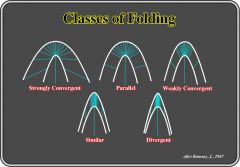
|
|
|
Ramsay's Dip Isogon Classification for Folds 2 |
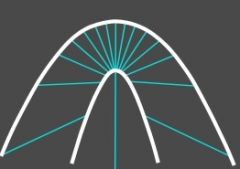
A. 1a Class Fold: 1. Strongly convergent |
|
|
Ramsay's Dip Isogon Classification for Folds 3 |
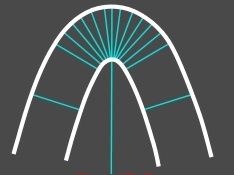
B. 1b Class Fold: 1. Parallel |
|
|
Ramsay's Dip Isogon Classification for Folds 4 |

C. 1c Class Fold: 1. Weakly Convergent
|
|
|
Ramsay's Dip Isogon Classification for Folds 5 |
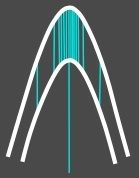
D. 2 Similar Class Fold: 1. Similar |
|
|
Ramsay's Dip Isogon Classification for Folds 6 |
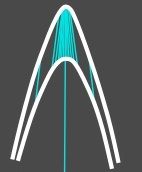
E. 3 Class Fold: 1. Divergent |
|
|
Cylindrical folds vs Non-cylindrical folds 1 |
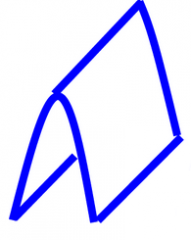
Cylindrical Folds: 1. Straight hinge lines. 2. Contain fold axes. |
|
|
Cylindrical folds vs Non-cylindrical folds |

Non- Cylindrical Folds: 1. Curved hinge lines. 2. Does not contain fold axes. |
|
|
Symmetric vs asymmetric folds 1 |

Symmetric: 1. Limbs have equal dips. |
|
|
Symmetric vs asymmetric folds 2 |
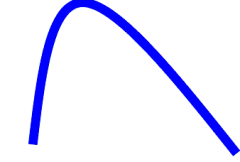
Asymmetric: 1. Unequal limb dip angles. |
|
|
Fold younging direction 1 |
Why is is important? 1. Younging direction given by primary structures in folds is important because it determines up and down and defines anticline or syncline. |
|
|
Four basic patterns of fold superposition 1 |
Superimposed fold: 1. Generations of folds that happen after the diagenesis of the bed and its first folding by tectonic events. 2. A superposed fold is younger than structure it folds. |
|
|
Four basic patterns of fold superposition 2 |
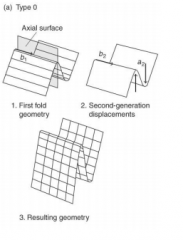
A. Type 0: 1. Cannot see as inteference type; axial surfaces parallel. |
|
|
Four basic patterns of fold superposition 3 |
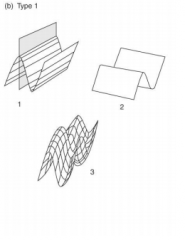
B. Type 1: 1. “Dome-and-basin” structure; egg-carton; axial surfaces normal. |
|
|
Four basic patterns of fold superposition 4 |
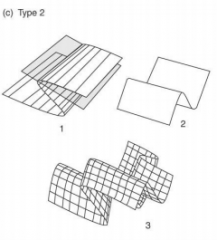
C. Type 2: 1. Most difficult to visualize; “mushroom” |
|
|
Four basic patterns of fold superposition 5 |
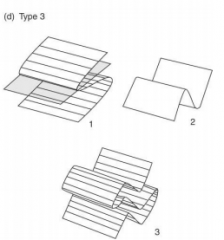
D. Type 3: 1. “Refolded folds” (all types are refolded) |
|
|
Fold classification by orientation of axial plane and fold axis 1 |
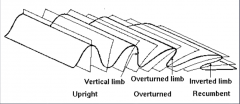
A. Axial plane: 1. Folds can be classified based on the dips of limbs and the axial plane. 2. The spectrum of fold orientations generally corresponds to a gradient in strain. |
|
|
Fold classification by orientation of axial plane and fold axis 2 |

B. Fold axis: 1. Folds can be classified based on the orientation of the fold axis. 2. Horizontal/Non-Plunging or 3. Plunging (Shallow, Moderate, Steep, Vertical, North, South, East, West, etc.) |
|
|
Fold profile view 1 |
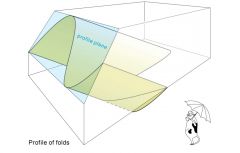
A folded surface is fully described in a plane perpendicular to the fold axis. The profile of a fold is the section drawn perpendicular to the fold axis and its axial surface; this contrasts with a geological section which is normally drawn in a vertical plane. |
|
|
Fold Types 1 |
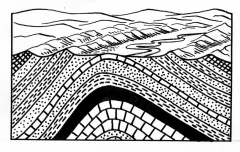
A. Anticline: linear, strata normally dip away from axial center, oldest strata in center. |
|
|
Fold Types 2 |
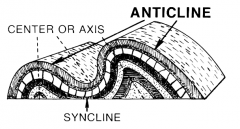
B. Syncline: linear, strata normally dip toward axial center, youngest strata in center. |
|
|
Fold Types 3 |

C. Antiform: linear, strata dip away from axial center, age unknown, or inverted. |
|
|
Fold Types 4 |

D. Synform: linear, strata dip toward axial centre, age unknown, or inverted. |
|
|
Fold Types 5 |
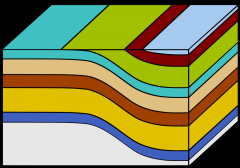
E. Monocline: linear, strata dip in one direction between horizontal layers on each side |
|
|
Fold Types 6 |

F. Chevron: angular fold with straight limbs and small hinges |
|
|
Fold Types 7 |

G. Recumbent: linear, fold axial plane oriented at low angle resulting in overturned strata in one limb of the fold. |
|
|
Fold Types 8 |
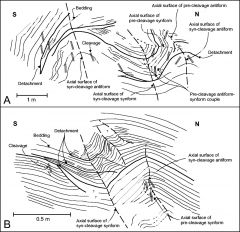
H. Slump: typically monoclinal, result of differential compaction or dissolution during sedimentation and lithification. |
|
|
Fold Types 9 |
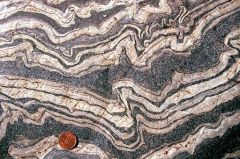
I. Ptygmatic: Folds are chaotic, random and disconnected. Typical of sedimentary slump folding, migmatites and decollement detachment zones. |
|
|
Fold Types 10 |
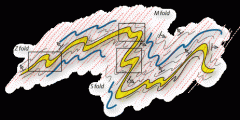
J. Parasitic: short wavelength folds formed within a larger wavelength fold structure - normally associated with differences in bed thickness. |
|
|
Fold Types 11 |
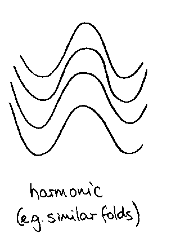
K. Disharmonic: Folds in adjacent layers with different wavelengths and shapes. |
|
|
Fold Types 12 |
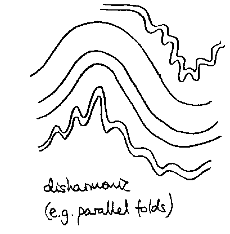
J. Harmonic: fold which maintains its geometric form, integral wavelength, and symmetry throughout a sequence of layers |
|
|
Parts of a fold 1 |

A. Crest. B. Hinge C. Limb D. Trough E. Inflection point: where sense of curvature changes. F. Hinge line: where curvature is the greatest. |
|
|
Parts of a fold 2 |

A. Enveloping surface (antiform / connect crest). B. Enveloping surface (synform / connect troughs) C. Synform: Valley D. Synclinorium: Regional E. Antiform: Hill G. Anticlinorium: Regional H. Enveloping surface: Defines limit of fold. |
|
|
Types of Unconformities 1 |

A. Angular unconformity: 1. Are those where an older package of sediments has been tilted, truncated by erosion, and than a younger package of sediments was deposited on this erosion surface. |
|
|
Types of Unconformities 2 |
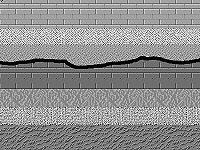
B. Disconformity: 1. The surface of a division between parallel rock strata, indicating interruption of sedimentation. |
|
|
Types of Unconformities 3 |

C. Non-conformity: 1. Are unconformities that separate igneous or metamorphic rocks from overlying sedimentary rocks. They usually indicate that a long period of erosion occurred prior to deposition of the sediments. |
|
|
Types of Faults 1 |

A. Dip-slip faults: Net slip vector parallels dip direction (within 10°). 1. Normal Fault 2. Thrust Fault 3. Reverse Faults |
|
|
Types of Faults 2 |

B. Strike-slip faults: Net slip vector parallels strike direction (within 10°). 1. Right-lateral 2. Left-lateral |
|
|
Types of Faults 3 |
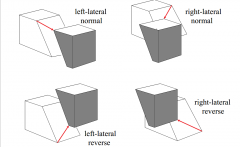
C. Oblique slip faults: Net slip vector not parallel to either strike or dip 1. Left-lateral normal. 2. Right-lateral normal. 3. Left-lateral reverse. 4. Right-lateral reverse. |
|
|
Types of Faults 4 |

D. Scissors/Hinge: One block rotates with respect to the other… rotation perpendicular to fault surface. |
|
|
Piercing Points 1 |
Piercing point is defined as a feature that is cut by a fault, then moved apart. Usually a geologic feature, preferably a linear feature. |
|
|
Components of Fault Displacement 1 |
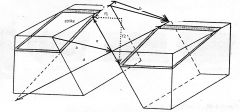
a. Net slip: Or total slip is the direct distance measured between the two originally adjacent points. b. Dip slip: Measure of distance between the line of strike and the adjacent point. c. Strike slip: Measure of distance between the point and where dip slip intersects strike. |
|
|
Components of Fault Displacement 2 |
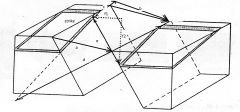
d. Strike separation: Component of separation parallel to strike. e. Dip separation: Component of separation parallel to dip. f1. Heave: Horizontal component of separation. f2. Throw: Vertical component of dip separation. |

